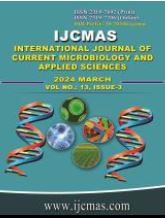


 National Academy of Agricultural Sciences (NAAS)
National Academy of Agricultural Sciences (NAAS)

|
PRINT ISSN : 2319-7692
Online ISSN : 2319-7706 Issues : 12 per year Publisher : Excellent Publishers Email : editorijcmas@gmail.com / submit@ijcmas.com Editor-in-chief: Dr.M.Prakash Index Copernicus ICV 2018: 95.39 NAAS RATING 2020: 5.38 |
In the present study an attempt was made for in vitro regeneration of bitter gourd cv. “BSS-1007”. In plant breeding tissue culture techniques play as an important role for rapid multiplication of particularly desirable genotype of F1 hybrids, gynoecious lines, triploid hybrid plants etc. where seed costs are high. Seeds of bitter gourd cv. BSS-1007 were surface sterilized with bavistin (0.1%) for 1 hr. followed by 70% ethanol (v/v) for 1 minutes and then 0.1% HgCl2 (w/v) solution for 5 minutes. After sterilization seeds were cultured on ½ MS medium for explants preparation. For direct multiple shoot induction, auxiliary bud and shoot apical meristem explants were cultured separately on MS media supplemented with different concentrations of BAP. Among these combinations, 1.0 mg/l BAP was found most effective for shoot induction from auxiliary buds producing maximum 3.19 numbers of shoots with minimum 7.30 days required for shoot initiation. While, MS medium fortified with 1.5 mg/l BAP was suitable for shoot induction from shoot apical meristem producing maximum 2.33 numbers of shoots with minimum 7.67 days required for shoot initiation. In vitro rooting of shoots was done by using MS medium fortified with different concentrations of IBA. Among these different rooting media, MS medium supplemented with 2.0 mg/l IBA was best for rooting on which highest average number of roots (40.71) were produced with minimum average days required for root induction (6.57days). Rooted plantlets were washed thoroughly and transferred to polythene cups containing coco-peat and acclimatized in green house condition.
Agarwal, M. 2015. Tissue culture of Momordica charantia L.: A review, J. Plant Sci. 15(3): 24-32. https://doi.org/10.11648/j.jps.s.2015030101.14
Agarwal, M., and Kamal, R. 2004. In vitro propagation of Momordica charantia. L. Ind. J. Biotechnol. 3: 426-430.
Huda, A. K., and Sikdar, B. 2006. In vitro plant production through apical meristem culture of bitter gourd (Momordica charantia L.). Plant Tissue Cult. Biotech. 16(1): 31-36. https://doi.org/10.3329/ptcb.v16i1.1103
Munsur, M. A., Haque, M. S., Nasiruddin, K. M., and Hasan, M. J. 2007. Regeneration of bitter gourd (Momordica charantia L.) from leaf segments and root tips. Progress. Agric. 18(2): 1-9.
Munsur, M. A., Haque, M.S., Nasiruddin, K. M., and Hossain, M. S. 2009. In vitro propagation of bitter gourd (Momordica charantia L.) from nodal and root Segments. Plant Tissue Cult. Biotech. 19(1): 45-52. https://doi.org/10.3329/ptcb.v19i1.4916
Murashige, T., and Skoog, F. 1962. A revised medium for rapid growth and bioassays with tobacco tissue culture. Physiol. Plant. 15: 473-497. https://doi.org/10.1111/j.1399-3054.1962.tb08052.x
Saha, S., and Behera, T. K. 2015. Standardization of techniques for in vitro multiplication of gynoecious line in bitter gourd. Int. J. plant Res. 28(4): 48-53. https://doi.org/10.5958/2229-4473.2015.00083.X
Singh, A., Singh, S. P., and Bamezai, R. 1998. Momordica charantia (Bitter gourd) peel, pulp, seed and whole fruit extract inhibits mouse skin papillomagenesis. Toxicol. Lett. 94: 37-46. https://doi.org/10.1016/s0378-4274(97)00099-4
Sinha, S., Sandhu, K., Bisht, N., Naliwal, T., Saini, I., and Kaushik, P. 2019. Ascertaining the paradigm of secondary metabolism enhancement through gene level modification in therapeutic plants. J. Young Pharma. 11: 337-343. https://doi.org/10.5530/jyp.2019.11.70
Sultana, R. S., Bari Miah, M. A., Rahman, M. M., Rahman, M. H., and Mollah, M. U. 2005. Aseptic multiplication and maintenance of bitter gourd (Momordica charantea L.) as affected by sucrose, agar and pH. J. Biological Sci. 5(6): 781-785.
Ugandha, T., Sammaia, D., Devi, U., and Srilatha, T. 2014. Plantlet regeneration from leaf explants through organogenesis in bitter melon (Momordica Charantia L.) Academic J. Interdisciplinary Studies MCSER Publishing, Rome-Italy. 3:79-84. https://doi.org/10.13140/RG.2.1.1844.0406
Verma, A. K., Kumar, M., Tarafdar, S., Singh, R., and Thakur, S. 2014. Development of protocol for micro propagation of gynoecious bitter gourd (Momordica charantia L). Int. J. Plant, Animal Env. Sci. 4: 275-280.
 |
 |
 |
 |
 |